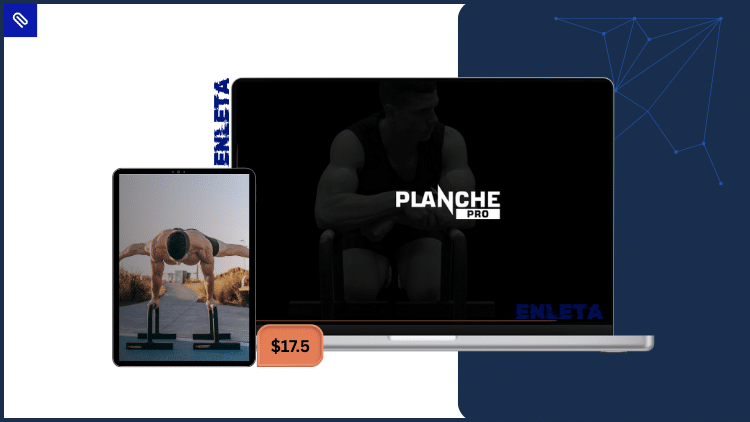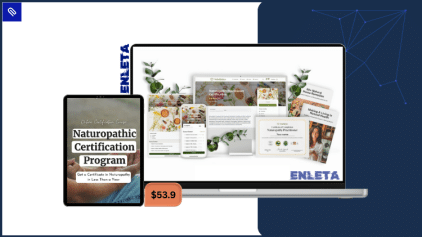Planche Pro by Daniel Vadnal – Digital Download!
Planche Pro by FitnessFAQs is a focused, evidence-informed calisthenics program built to help you acquire the planche—from foundational lean mechanics and tuck holds to advanced tuck and straddle progressions—within a clear, repeatable 16-week structure. Instead of leaving you to guess which drills to stack or how long to hold an isometric, the curriculum sequences technique, strength, and accessory work so you can build straight-arm strength safely while protecting the wrists, elbows, and shoulders. You’ll learn how to maintain a true hollow body line, keep the scapulae protracted and depressed under load, and lock the elbows without sacrificing joint health. The material is written for all levels: complete beginners who only have a planche lean, intermediates stuck at tuck or advanced tuck, and advanced trainees who want to improve line quality and time under tension at straddle.
Planche Pro by Daniel Vadnal Free Download – Includes Verified Content:
Planche Pro – Free Download Video Sample:
Planche Pro – Overview this course
The program’s appeal is its blend of biomechanics clarity and practical programming. You get weekly targets, progression criteria, and form diagnostics that turn the planche from a mysterious “holy grail skill” into a measurable training project. The structure can be cycled again and again—each pass slightly increases lever length, hold duration, or quality of your line—so progress compounds even if your schedule, recovery, or training environment changes. Whether you train on the floor or on parallettes, at home or in a minimalist gym, the templates remain relevant and scalable.
Why should you choose this course?
A 16-week progression you can trust. Planche progress stalls for two reasons: poor mechanics and poor load management. Planche Pro addresses both. The 16-week macrocycle balances exposure (lever length and hold time) with recovery (deload logic, autoregulation cues), so you train enough to grow without exceeding your tissues’ tolerance. Each week specifies how to advance lever, sets, seconds, and accessory volume.
Technique first, always. Planche success lives or dies on line integrity: hollow body, posterior pelvic tilt (PPT), and locked-out elbows while the shoulder blades stay protracted and depressed. The program bakes these cues into every drill, teaching you to hold the shape rather than “muscle through” with bent elbows or collapsed scapulae. This technique-centric approach produces a cleaner line, greater force transfer, and fewer overuse niggles.
Progressions without guesswork. You don’t have to decide if today is lean work, tuck holds, or eccentric entries—Planche Pro does the sequencing for you. Drills move logically from easier to harder lever positions, and each phase includes objective criteria for “when to progress.” If your form slips, the program shows you how to scale the lever or volume while preserving quality.
Minimalist and portable. No machines, no crowded gym. You can complete the plan on the floor or with parallettes and a small training area. That simplicity makes consistency easier—and consistency is the real “secret” to isometric skills.
Proven calisthenics methodology. The teaching style blends physiotherapy-grade joint care with practical coaching. Instead of a random library of exercises, you get a coherent system: prime, practice, strengthen, then finish with accessories that support the main skill.
What You’ll Learn
1) Planche biomechanics made practical
You’ll build a deep understanding of the planche line: how to maintain a hollow body under fatigue; how PPT reduces lumbar shear and prevents the banana-back; why scapular protraction and depression stabilize the shoulder; and how a true elbow lockout lets you transfer load through the skeletal chain without “leaking” force. These principles show up in every drill and every coaching cue, turning abstract anatomy into tangible performance.
2) A progression map from zero to straddle
-
Phase 1 – Foundations (Lean & Tuck): Establish a perfect planche lean, learn to create full-body tension, and accumulate short, clean tuck holds. Supplemental scapular mechanics (protraction push-ups, straight-arm scap raises) teach your shoulders to stay active.
-
Phase 2 – Capacity (Tuck to Advanced Tuck): Increase lever length by opening the hips, integrate controlled eccentrics into advanced tuck, and introduce compression drills to manage center-of-mass.
-
Phase 3 – Consolidation (Advanced Tuck): Grow time under tension with cluster sets, refine line quality, and strengthen the wrists through progressive leans at the new lever.
-
Phase 4 – Expression (Straddle Entry): Practice band-assisted or low-amplitude straddle entries, maintain scapular position under greater torque, and learn to “own” the shape for repeatable 5–10 second efforts.
3) Programming that respects joints and progress
You’ll learn how to dose isometric holds (e.g., 6–12 total high-quality efforts), use tempo eccentrics for skill imprinting, and balance heavy, medium, and light days by watching line quality and rate of perceived exertion (RPE). The plan teaches deload planning and how to recycle the 16-week cycle at a harder lever without starting over.
4) Accessory pillars that unlock the planche
-
Scapular strength: protraction/depression under straight-arm load, serratus anterior activation, and anti-retraction control when fatigue sets in.
-
Core & compression: hollow holds, PPT drills, and hip-flexion work to “shorten” lever demands by smarter positioning rather than brute strength.
-
Wrist conditioning: progressive tolerance, angles, and range prep so your wrists keep up with stronger levers.
-
Shoulder/elbow integrity: straight-arm support work, biasing tendon capacity while preventing micro-bends.
5) Diagnostic checklists and error correction
You’ll get form checklists to spot the usual culprits: collapsing scapulae, soft elbows, banana back, hips piking, or wrists overly extended. Each fault has a regression or a cue (e.g., elevate hands on parallettes, reduce lever, shorten hold time) so quality remains high while you continue to accumulate volume.
6) Recovery and warm-up frameworks
The course standardizes skill-specific warm-ups—focused wrist prep, shoulder activation, and “capillarization” sets that lubricate positions before heavy holds. You’ll also learn how to scale weekly frequency (typically 3–5 exposures) for skill acquisition without overreaching.
7) Equipment setups that make training easier
Floor is fine; parallettes often feel better for wrists and give you clearer leverage. You’ll learn how to choose hand width, parallette height, and surface friction so you can reproduce positions reliably.
8) Mindset, logging, and testing
Objective milestones keep you honest: e.g., clean 10–15s tuck; 8–12s advanced tuck; 5–8s straddle attempts. You’ll film periodic test days, evaluate elbow lock, scapular position, and line, then use that data to set the next cycle’s targets.
Who Should Take This Course?
Beginners to calisthenics who want a safe, structured entry into straight-arm strength. If your only exposure is planche lean and you’ve never held a tuck, the checklist-driven approach prevents the common mistakes that cause plateaus and aches.
Intermediates stuck at tuck or advanced tuck who can’t convert practice into longer holds at a cleaner lever. The progression criteria (time, line, lever) and autoregulated volume are ideal for breaking through.
Advanced athletes seeking straddle consistency, better line aesthetics, and longer time under tension without sacrificing joint health. The accessory pillars plug gaps you may have hidden behind brute force.
Home and minimalist trainees who value a plan that works on the floor or with parallettes and fits into tight schedules. The templates are portable and repeatable, even when life gets busy.
Calisthenics coaches who want a repeatable SOP for dozens of athletes. The program’s structure—warm-ups, main skill, accessories, diagnostics—scales into small-group classes or 1:1 coaching without reinventing the wheel.
A 16-week implementation roadmap (example)
Weeks 1–4 — Base & Technique
-
Goal: own the planche lean and perfect tuck mechanics.
-
Warm-up: wrist ramps, scap protraction drills, controlled lean pulses.
-
Main: multiple short tuck holds (e.g., 6–10s) with strict elbow lock, plus straight-arm scap work.
-
Accessories: hollow body, PPT breathing, light compression drills.
Weeks 5–8 — Lever & Volume
-
Goal: extend tuck hold duration and begin advanced-tuck eccentrics.
-
Main: tuck clusters (e.g., 3 × 8–12s total), intro to advanced-tuck negatives.
-
Accessories: wrist tolerance progression, hip-flexion and compression.
-
Autoregulation: if line degrades, reduce lever before reducing effort count.
Weeks 9–12 — Advanced Tuck Consolidation
-
Goal: accumulate quality volume at advanced tuck with minimal line drift.
-
Main: mixed sets of holds and eccentrics, optional band-assist for longer exposures.
-
Accessories: serratus endurance, anti-retraction drills to resist scap collapse.
-
Deload: strategic in week 12 based on form video and joint feedback.
Weeks 13–16 — Straddle Entry
-
Goal: controlled straddle exposures (band-assist or small range), maintain protraction/depression.
-
Main: straddle attempts backed by advanced-tuck volume, short and clean.
-
Test Day: film, measure hold time and line; set the next cycle’s plan at a slightly harder lever or longer TUT.
Repeat the macrocycle, nudging lever length, hold durations, or quality standards upward. That loop—practice, measure, repeat—turns an elite skill into a solvable problem.
Common pitfalls this course helps you avoid
-
Chasing time before line. You’ll learn to prioritize shape integrity over seconds, preventing bad habits that later cap progress.
-
Using bent-arm compensation. Soft elbows hide weakness and overload elbows and biceps tendons. The plan teaches true straight-arm support.
-
Ignoring wrists. Isometric torque punishes unprepared wrists. Progressive angles and exposure fix that.
-
Random accessory work. Every accessory in the plan supports the skill—no fluff that drains recovery.
-
Overtraining. With built-in deloads and autoregulation, volume scales to your readiness rather than a rigid calendar.
Conclusion
Elite bodyweight skills demand both precision and patience. Planche Pro delivers a systematic 16-week framework that brings those qualities together—clear biomechanics, step-by-step progressions from tuck to advanced tuck and straddle, joint-smart programming, and diagnostics that keep your line honest. Whether you’re just learning the lean or chasing longer straddle holds, you’ll move away from guesswork and toward a measurable, repeatable process. The emphasis on hollow body mechanics, scapular control, elbow lockout, and wrist conditioning means you’ll not only get stronger—you’ll also train in a way that respects your joints and sustains progress across multiple cycles. If you want a plan that turns the planche from a vague dream into a concrete training outcome, Planche Pro is built for you.
👍Start your 16-week planche journey today—commit to Planche Pro, master clean straight-arm mechanics, and turn elite skill into repeatable strength.










Reviews
There are no reviews yet.